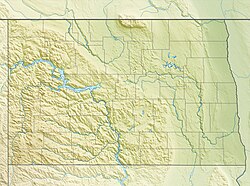| Golden Valley Formation | |
|---|---|
| Stratigraphic range: Late Paleocene-Early Eocene (Clarkforkian-Wasatchian) ~ | |
| Type | Geological formation |
| Sub-units | Bear Den & Camels Butte Members |
| Underlies | White River Group |
| Overlies | Sentinel Butte Formation |
| Thickness | up to 122 metres (400 ft)[1] |
| Lithology | |
| Primary | Claystone, mudstone, siltstone, sandstone |
| Other | Lignite, conglomerate |
| Location | |
| Coordinates | 48°30′N 102°42′W / 48.5°N 102.7°W |
| Approximate paleocoordinates | 52°54′N 82°12′W / 52.9°N 82.2°W |
| Region | North Dakota |
| Country | |
| Extent | Williston Basin |
| Type section | |
| Named for | Golden Valley, North Dakota |
| Named by | Benson & Laird[2] |
| Year defined | 1947 |
The Golden Valley Formation is a stratigraphic unit of Late Paleocene to Early Eocene age in the Williston Basin of North Dakota.[3] It is present in western North Dakota and was named for the city of Golden Valley by W.E. Benson and W.M. Laird in 1947.[2] It preserves significant assemblages of fossil plants[3] and vertebrates,[4] as well as mollusk and insect fossils.[3][4]
- ^ Cite error: The named reference
Murphywas invoked but never defined (see the help page). - ^ a b Benson, W.E. and Liard, W.M. (1947). Eocene of North Dakota. Geological Society of America Bulletin, vol. 60, pp. 1166–1167.
- ^ a b c Hickey, 1977
- ^ a b Jepsen, G.L. 1963. Eocene vertebrates, coprolites, and plants in the Golden Valley Formation of western North Dakota. Geological Society of America Bulletin, vol. 74, pp. 673–684.

